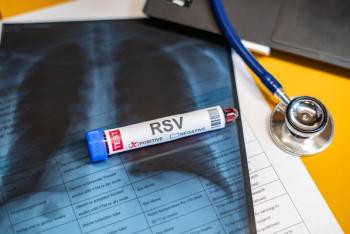
Screening for Eye Problems in Patients With Diabetes
Peter Salgo, MD: Now, in order to prevent that, I would think that the straightforward logic, anyway, was “Let’s look at everybody, let’s look at everybody all the time.” Live in your office. “Well, you were okay a minute ago, what about now?”
Â
We can’t do that. But what is the recommendation for eye exams in the diabetic population? How often do you want to see them?
Â
John W. Kitchens, MD: The American Academy of Ophthalmology and the American Diabetes Association both recommend if you’re a type 2 diabetic that you undergo a baseline screening examination shortly after diagnosis. If you’re a type 1 diabetic, within 5 years after your diagnosis.
Â
We really want to try and establish whether or not these patients have any form of vision-threatening retinopathy. The type 2 patients may not know when they develop type 2 and that’s why we want to see them right away.
Â
Peter Salgo, MD: I see. In other words, if I understand what you’re saying correctly, if you could tell instantaneously, “Well, you just got type 2 diabetes,” you’d like to see them right then–or 5 years from then, actually, compared to the type 1s.
Â
John W. Kitchens, MD: Exactly.
Â
Peter Salgo, MD: Because they present pretty acutely.
Â
Steven Peskin, MD, MBA, FACP: And we focus on the annual exam. Within the health plan, Health Effectiveness Data and Information Set and the annual dilate exam that can be done by an optometrist as well as an ophthalmologist.
Â
So that’s a particular focus we have and my clinical role in teaching residents, as you do, that in the outpatient setting where I am, again, we look for annual retinal exam, as well as monofilament test of the feet, as well as screening for microalbumin.
Â
Rishi P. Singh, MD: And let’s add two more populations to this discussion. The first is the gestational diabetic, which I think is becoming far more common as we’re seeing.
Â
Peter Salgo, MD: I was wondering if you would get to that.
Â
Rishi P. Singh, MD: And patients are getting pregnant older, and they’re having complications from some of the drugs that are part of their fertility measures.
Â
So they have to be evaluated every trimester, in fact, until their time to deliver. And after delivery is also an optimal time because of the blood flow changes as well as the pressure related to the delivery process.
Â
Peter Salgo, MD: Okay. Well, let me ask a loaded question because I’m asked this all the time. Again, with older deliveries, older women, is gestational diabetes ‘diabetes,’ and are the ophthalmologic consequences of gestational diabetes the same as ‘all-comers’ diabetics? You brought this up. You have the hot potato.
Â
Rishi P. Singh, MD: Well, I would say the answer, in my professional opinion, is no. They basically have a set point of diabetes for that period of time where they’re pregnant and they then go back to normal glycemia.
Â
But, the patient who’s at most risk is that patient who is diabetic and pregnant because that patient has a very, very large blood volume change, as well as blood pressure change. Their diabetes can be pretty much uncontrolled for that period because they’re trying to, obviously in that gestational phase, provide for the child. They don’t have, necessarily, the same control that they would have necessarily.
Â
And to add to the other population there, I think that’s important. And we bring this up in screening, but also for follow up. For the patient who had proliferative or non-proliferative disease, we’re seeing them far more frequently than once a year. We’re seeing them almost every three months, six months, depending on their treatment regimen. We are seeing them because they’re at very high risk of developing vision-threatening retinopathy.
Â
Steven Peskin, MD, MBA, FACP: And in that construct of early warning signs, we got the term ‘pre-diabetes.’ So, for those populations that have a propensity, or we feel like may develop diabetes and these awful complications like proliferative retinopathy and diabetic macular edema, we work with our clinical partners to address lifestyle, so that we may be preventing this epidemic from continuing.
Â
John W. Kitchens, MD: Steven said something very important a couple of minutes ago, which was “It’s got to be a dilated eye examination.” I think that patients and physicians need to realize that this is not a glasses exam. This is not a go in and a puff of air. You want to dilate the eye so you can actually look into the back and make an appropriate diagnosis of whether or not they have disease.
Â
Peter Salgo, MD: Bring your sunglasses with you to the exam if the sun is out. It’s going to be bright when you leave the office.
Â
Rishi P. Singh, MD: That’s really a difference between some of the care providers we have in our field. I think some of the providers in some of the other specialties may not necessarily do all the imaging and all the dilation as part of that. They may provide the patient options of imaging, and things like that, that aren’t necessarily superior or equivalent to the dilated eye exam…at least in the American Academy of Ophthalmology standards.
Â
Peter Salgo, MD: Now, we’ve got, pardon me for saying so, a very select group here. We have people here, on our panel, who see eye patients. And so, everybody who sees you is coming to be seen by an ophthalmologist. Some of them have been seen by optometrists. But in regard to all-comers and all diabetics, what percent of that population is being screened at all?
Â
John W. Kitchens, MD: It’s only about 50%. And that’s a really scary thing. We’re leaving 50% of our at-risk patients out there. And there’s a variety of reasons, a variety of barriers, why these patients aren’t getting their examination.
Â
From the fact that they don’t appreciate that the diabetes affects their eyes. And that really starts with primary care doctors starting to emphasize to those patients, along with the litany of other things they have to talk about, that their eyes are involved with this and that this can lead to blindness, and the importance of that dilated eye exam.
Â
Peter Salgo, MD: Is this our fault we haven’t proselytized enough? We haven’t told them enough?
Â
John W. Kitchens, MD: We’ve got a hard job.
Â
Rishi P. Singh, MD: Yeah.
Â
Peter Salgo, MD: I don’t care if it’s hard. We’re supposed to do it. Is it our fault?
Â
Rishi P. Singh, MD: My wife is an internist, and she tells me that she sees 10 patients a day and they have 10 medical problems. So therefore, she’s seeing 100 patients. That’s a tough scenario to be in, when you have a patient with very, very difficult medical scenarios and you are trying to treat all of them.
Â
We actually did a study at Cleveland Clinic recently, where we looked at the charts of both endocrinologists and internists, and looked to see whether they mentioned the eye-related issues during their examination.
Â
We found that the endocrinologists asked, pretty reliably, around 75% or 80% of the time, on all their patients. The internists failed to ask it, probably because they are so inundated with everything else, that they failed to get to that point. Only about 15% or 20% of the time did they ever really ask that question about retinopathy or eye-related issues in the diabetic patient.
Newsletter
Stay ahead of policy, cost, and value—subscribe to AJMC for expert insights at the intersection of clinical care and health economics.












































